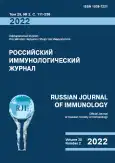Связь цитокинов и численности микросимбионтов при микроэкологических нарушениях кишечника человека
- Авторы: Бондаренко Т.А.1, Иванова Е.В.1, Бекпергенова А.В.1, Чайникова И.Н.1, Челпаченко О.Е.1, Никифоров И.А.1, Здвижкова И.А.1
-
Учреждения:
- ФГБУН «Оренбургский федеральный исследовательский центр» УрО РАН
- Выпуск: Том 25, № 2 (2022)
- Страницы: 125-130
- Раздел: КРАТКИЕ СООБЩЕНИЯ
- URL: https://journals.rcsi.science/1028-7221/article/view/120159
- DOI: https://doi.org/10.46235/1028-7221-1112-RBC
- ID: 120159
Цитировать
Полный текст
Аннотация
Цитокины и хемокины, кишечные микросимбионты, являясь необходимыми участниками межклеточных коммуникаций в норме, поддерживая гомеостаз слизистой оболочки кишечника, могут быть ключевыми факторами воспаления кишечника и повреждения эпителиального барьера. Данная работа расширяет представления о взаимосвязи микробных сообществ кишечника с локальной цитокиновой сетью хозяина. В работе представлены результаты анализа корреляционных связей таксономического состава кишечных микросимбионтов и уровня про- (TNFα, IFNγ, IL-8) и противовоспалительных цитокинов (IL-10, IL-1ra) в копрофильтратах клинически здоровых людей, обследуемых на дисбиоз. Определение цитокинов в копрофильтратах проводилось ИФА (АО «Вектор-Бест», Россия). Исследование 65 микросимбиоценозов кишечника человека осуществлялось классическим бактериологическим методом. Идентификацию облигатно-анаэробных (Bifidobacterium spp., Bacteroides spp., Cutibacterium acnes, Clostridium spp.) и факультативно-анаэробных бактерий (Escherichia coli, Klebsiellae spp., Pseudomonas aeruginosa, Enterobacter spp., Citrobacter freundii, Proteus mirabilis, Streptococcus spp., Staphylococcus spp., Enterococcus faecium) и Candida spp. проводили времяпролетной масс-спектрометрией MALDI TOF MS серии Microflex LT (Bruker Daltoniсs, Германия). Проведенные исследования выявили значимую роль при дисбиозе кишечника ассоциаций энтеробактерий с дрожжевыми грибами и стафилококками. В структуре облигатно-анаэробного звена микробиоты наблюдалась смена консорциумов из нескольких видов бифидобактерий и лактобактерий при эубиозе на моновидовой вариант при дисбиозе. При этом увеличивалось количество ассоциаций, в состав которых входили клостридии. Анализ корреляционных связей показателей цитокинов и численности микробиоты кишечника показал сохранение в условиях дисбиоза установленных при эубиозе значимых связей с увеличением их коэффициента корреляции: Bifidobacterium spp., Enterobacteriaceae, Staphylococcus spp., Candida spp. с TNFα. Вместе с тем при дисбиозе менялась направленность связей и определялись новые корреляционные связи: для Staphylococcus spp. и IFNγ; Staphylococcus spp. и IL-8; Enterobacteriaceae и IL-1ra, IFNγ. Установленные особенности корреляционных связей между показателями микросимбиоценоза и количественными изменениями цитокинов позволяют рассматривать таксономический состав микросимбиоценоза и профиль цитокинов как фактор, который может влиять на состояние гомеостаза кишечника при эу- и дисбиозе.
Ключевые слова
Полный текст
Открыть статью на сайте журналаОб авторах
Таисия Александровна Бондаренко
ФГБУН «Оренбургский федеральный исследовательский центр» УрО РАН
Email: semenovih88@mail.ru
научный сотрудник лаборатории инфекционной симбиологии, Институт клеточного и внутриклеточного симбиоза Уральского отделения Российской академии наук
Россия, 460000, Оренбург, ул. Пионерская, 11Елена Валерьевна Иванова
ФГБУН «Оренбургский федеральный исследовательский центр» УрО РАН
Автор, ответственный за переписку.
Email: walerewna13@gmail.com
д.м.н., доцент, ведущий научный сотрудник лаборатории инфекционной симбиологии, Институт клеточного и внутриклеточного симбиоза Уральского отделения Российской академии наук
Россия, 460000, Оренбург, ул. Пионерская, 11Анастасия Владимировна Бекпергенова
ФГБУН «Оренбургский федеральный исследовательский центр» УрО РАН
Email: nsavasteeva@gmail.com
к.б.н., старший научный сотрудник лаборатории инфекционной симбиологии, Институт клеточного и внутриклеточного симбиоза Уральского отделения Российской академии наук
Россия, 460000, Оренбург, ул. Пионерская, 11Ирина Николаевна Чайникова
ФГБУН «Оренбургский федеральный исследовательский центр» УрО РАН
Email: inchainicova@yandex.ru
д.м.н., профессор, ведущий научный сотрудник лаборатории инфекционной симбиологии, Институт клеточного и внутриклеточного симбиоза Уральского отделения Российской академии наук
Россия, 460000, Оренбург, ул. Пионерская, 11Ольга Ефимовна Челпаченко
ФГБУН «Оренбургский федеральный исследовательский центр» УрО РАН
Email: oech57@gmail.com
д.м.н., профессор, ведущий научный сотрудник лаборатории инфекционной симбиологии, Институт клеточного и внутриклеточного симбиоза Уральского отделения Российской академии наук
Россия, 460000, Оренбург, ул. Пионерская, 11Игорь Александрович Никифоров
ФГБУН «Оренбургский федеральный исследовательский центр» УрО РАН
Email: ianikiforov@rambler.ru
к.г.-м.н., ведущий научный сотрудник лаборатории инфекционной симбиологии, Институт клеточного и внутриклеточного симбиоза Уральского отделения Российской академии наук
Россия, 460000, Оренбург, ул. Пионерская, 11Ирина Александровна Здвижкова
ФГБУН «Оренбургский федеральный исследовательский центр» УрО РАН
Email: zdvizhkova.irina@gmail.com
научный сотрудник лаборатории инфекционной симбиологии, Институт клеточного и внутриклеточного симбиоза Уральского отделения Российской академии наук
Россия, 460000, Оренбург, ул. Пионерская, 11Список литературы
- Иванова Е.И., Бондаренко Т.А., Чайникова И.Н., Перунова Н.Б. Локальные антимикробные факторы и цитокины при дисбиозе кишечника человека // Российский иммунологический журнал, 2015. Т. 9 (18), № 2 (1). С. 691-692. [Ivanova E.I., Bondarenko T.A., Chaynikova I.N., Perunova N.B. Local antimicrobial factors and cytokines in human intestinal dysbiosis. Rossiyskiy immunologicheskiy zhurnal = Russian Journal of Immunology, 2015, Vol. 9 (18), no. 2 (1), рp. 691-692. (In Russ.)]
- Andrews C., McLean M.H., Durum S.K. Cytokine tuning of intestinal epithelial function. Front Immunol., 2018, Vol. 9, 1270. doi: 10.3389/fimmu.2018.01270.
- Ciesielska A., Matyjek M., Kwiatkowska K. TLR4 and CD14 trafficking and its influence on LPS-induced pro-inflammatory signaling. Cell. Mol. Life Sci., 2021, Vol. 78, no. 4, pp. 1233-1261.
- Hirayama D., Iida T., Nakase H. The phagocytic function of macrophage-enforcing innate immunity and tissue homeostasis. Int. J. Mol. Sci., 2018, Vol. 19, no. 1, 92. doi: 10.3390/ijms19010092.
- Hou K., Wu Z.X., Chen X.Y., Wang J.Q., Zhang D., Xiao C., Zhu D., Koya J.B., Wei L., Li J., Chen Z.S. Microbiota in health and diseases. Signal Transduct. Target. Ther., 2022, Vol. 7, no. 1, 135. doi: 10.1038/s41392-022-00974-4.
- Jeffery V., Goldson A.J., Dainty J.R., Chieppa M., Sobolewski A. IL-6 signaling regulates small intestinal crypt homeostasis. J. Immunol., 2017, Vol. 199, рр. 304-311.
- Jones S.A., Bryant C., Lloyd C.M., McInnes I., O’Neill L. A vision for cytokine biology with 20/20 clarity. Function (Oxf.), 2020, Vol. 2, no. 1, zqaa042. doi: 10.1093/function/zqaa042.
- Neurath M.F. Cytokines in inflammatory bowel disease. Nat. Rev. Immunol., 2014, Vol. 14, no. 5, рр. 329-342.
- Pascale A., Marchesi N., Marelli C., Coppola A., Luzi L., Govoni S., Giustina A., Gazzaruso C. Microbiota and metabolic diseases. Endocrine, 2018, Vol. 61, рр. 357-371.
- Peterson L.W., Artis D. Intestinal epithelial cells: regulators of barrier function and immune homeostasis. Nat. Rev. Immunol., 2014, Vol. 14, no. 3, рр. 141-153.
- Sumagin R., Robin A.Z., Nusrat A., Parkos C.A. Transmigrated neutrophils in the intestinal lumen engage ICAM-1 to regulate the epithelial barrier and neutrophil recruitment. Mucosal Immunol., 2014, Vol. 7, no. 4, рр. 905-915.
Дополнительные файлы








